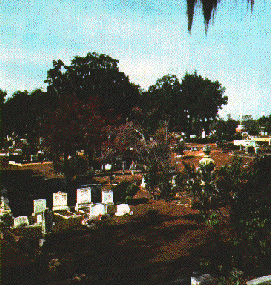Download the full brochure on the Old City Cemetery (PDF)
Most of the material in this overview of the Old City Cemetery is taken from a series of publications of the former Historic Tallahassee Preservation Board. In the early 1990s, The Board undertook an evaluation and restoration (assisted by Sass Conservation, of New York City, and the Center for Historic Cemeteries Preservation) of many of the cemetery's treasures.
Early History

Old City Cemetery is the oldest public cemetery in Tallahassee. It was established in 1829 by the Territorial Legislative Council and acquired by the city in 1840. The ground was laid out in its system of squares and lots in 1841 when a violent yellow fever epidemic swept the city and regulations were required to assure order and sanitation to protect the public.
When the cemetery was established, it was located outside the City boundaries on the far side of a 200-foot-wide clearing that surrounded the town to protect it from Indian attacks. Today, Old City Cemetery is one of Tallahassee's most distinctive historic sites. It is the final resting place for many of the men and women who contributed to the development of Tallahassee and the state of Florida. Because it was Tallahassee's only public burying ground (nearby St. John's Episcopal Cemetery was established for its congregation in 1840), Old City Cemetery represents a cross-section of Tallahassee's people during the 19th century -- slaves and planters, governors and store clerks, veterans of wars and victims of yellow fever are all buried here.
Segregated Burials
When established, the cemetery was segregated. White burials were restricted to the eastern half of the ground (ironically, along what is now known as Martin Luther King, Jr., Boulevard), and slaves and free people of color were buried in the western section (along present-day Macomb Street). After the Civil War Battle of Natural Bridge, Union casualties were buried in the colored section, and Confederates in the white.
The segregation was not only physical, but administrative. The ordinance establishing the cemetery (published August 21, 1841, in the Florida Sentinel) said:
It shall further be the duty of the superintendent to keep two separate books, in one of which he shall fairly and accurately register the interment of white persons, and in the other the interment of all negroes and persons of color in this burial ground.... The latter book... shall distinguish between free persons of color from slaves, and stating the date of interment, the name of the person interred, and if a slave, the owner's name, the age, place of nativity, time of residence in the city, and the disease or casualty of which the person died.
At present a pathway about six feet wide indicates the old dividing line between the white and colored sections of the cemetery. A former caretaker of the cemetery, Mr. Sneed Hall, once recalled that in the 1950s a hogwire fence (partially screened from view by plantings of camphor trees and bamboo, some of which still remain in the southern section) ran from north to south down the center of the burying ground.
(For further information about segregated burial practices in Tallahassee, some of which persisted well into the 20th Century, see the history of Greenwood Cemetery.)
Various religious denominations had designated plots, although today there are few indications of the Presbyterian and Catholic areas. The Jewish section was originally established in 1890 in "the first 2 lots north of the main Eastern entrance"; however this section turned out to be unsuitable and it was relocated to the western edge of the northeast quadrant of the cemetery, near the crest of the hill. There is a large obelisk there with the Star of David over the inscription, but it is believed that most of the burials at the turn of the century were later moved to Jacksonville.
Cattle and Hogs
The cemetery seems to have been a desolate place during the Territorial and early statehood years. Contemporary newspaper accounts from the period remark about cattle and hogs running over the graves and often complain of the rough and unkempt appearance of the site. In 1834, one Tallahassee resident was so dismayed about the way burials were conducted that he wrote a letter to the editor suggesting that the City Council provide a one-horse hearse to replace "the custom of bringing the coffin in a rough cart."
The same writer also deplored the "very insecure and objectionable manner of lowering the silent tenant to his last sad dwelling, by merely slipping ropes underneath the coffin. This practice must always result in distracting the attention from the solemn services of the grave, in exciting painful anxiety for the living and the dead, and sometimes in accidents agonizing to the mourners and appalling to the spectators."
Grave Markers
Tallahassee was a frontier town during its first years and residents had to "make do" with what was available to them. Many early graves were marked with wooden head and footboards, which deteriorated over time.
The grave markers in Old City Cemetery are memorials to those buried here. They are also artistic expressions that reflect changing cultural attitudes toward death and resurrection. The early markers that have survived are of marble and usually have simple designs and inscriptions that express grief and mourning. Later markers reflect the Victorian period's interest in classical art and architecture. Unfortunately, because of the difficulty and expense of maintaining and repairing these historic markers, no stone rubbings are permitted in Old City Cemetery.